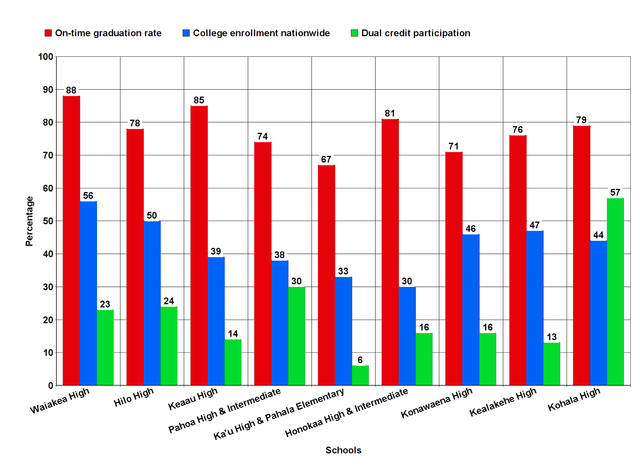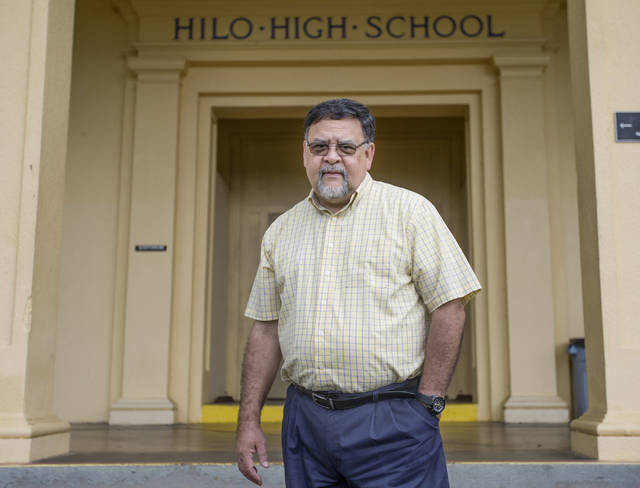HILO — More Big Island high school students enrolled in college and participated in dual-credit programs last year, but four-year high school graduation rates dropped slightly. ADVERTISING HILO — More Big Island high school students enrolled in college and participated
HILO — More Big Island high school students enrolled in college and participated in dual-credit programs last year, but four-year high school graduation rates dropped slightly.
That’s according to the latest College and Career Readiness Indicators Report, a yearly school-by-school snapshot that aims to gauge how well students are prepared for life post-graduation. The report is compiled by a statewide education consortium called Hawaii P-20 Partnerships for Education. It was released last week.
According to the report, 44.5 percent of graduates from Hawaii Island’s nine public, noncharter schools enrolled in college, up from 43.9 percent in 2015 but down from 47.3 percent in 2014. Statewide, 55 percent of 2016 grads enrolled in college.
Every Big Island high school reported more students earning college credit through programs such as Running Start or Early College: 22 percent of students islandwide were dual-credit earners last year, up from 8.6 percent in 2015 and 6.7 percent in 2014. Dual-credit programs allow students to earn college credit while still in high school.
The four-year graduation rate among island high school students decreased, however, from about 80.3 percent in 2015 to 77.7 percent last year. Statewide it was 82 percent in 2016 — the same since 2014.
In a presentation last week to the state Board of Education, Hawaii P-20 Executive Director Steve Schatz lauded data overall — particularly dual-credit participation — which increased from 10 percent statewide in 2015 to 14 percent last year.
The P-20 report also assesses Career Technical Education program participation (such as automotive technology or computer networking), the number of students taking ACT and Advanced Placement exams, among other indicators.
“When we administer the ACT, we ask students their aspirations and we find that most really aspire to go to college in some way shape or form,” Schatz told the board. “ … (But) there’s an aspirations gap between what students say they want to do and what actually happens … Where you see some degree of hope is those students participating in dual-credit.”
Hilo, Pahoa, Kealakehe, Konawaena and Kohala high schools were among the Big Island schools that more than doubled the number of students earning college credit.
Hilo High bumped dual-credit earners from 10 percent in 2015 to 24 percent last year. It also increased its number of ACT exam takers by nearly 30 students and bumped the number of students completing a Career Technical Education program from 58 students in 2015 to 92 students last year.
Pahoa High and Intermediate School also increased its year-over-year dual-credit earners. That number jumped from 4 percent in 2015 to 30 percent last year.
Principal Darlene Bee attributed the increase to Pahoa’s participation in Hawaii Community College’s Early College program. The grant-funded program is free for students. It brings HCC instructors to Pahoa during the school day to teach dual-credit courses. In particular, Early College has helped Pahoa students earn college credit who might otherwise have trouble with transportation or paying tuition, Bee said in an email.
Kealakehe High, which also saw multiple improvements, attributed them in part to the presence of HCC’s new Palamanui campus. The campus “helps students feel inspired,” Principal Will Murakami told the Tribune-Herald, and provides “a real college campus we can go and visit.”
Kealakehe reported 13 percent dual-credit participation last year, up from 2 percent in 2015. It also saw a slight increase in its graduation rate, a 14 percent increase in Career Technical Education participation and an increase in the number of students enrolling in college.
Murakami said the school wants to see dual-credit participation increase even more.
“Within the next two to three years, we want at least 25 percent of our students earning college credit,” he said.




